+ データを開く
データを開く
- 基本情報
基本情報
| 登録情報 |  | |||||||||
|---|---|---|---|---|---|---|---|---|---|---|
| タイトル | Structure of Apo CXCR4/Gi complex | |||||||||
 マップデータ マップデータ | ||||||||||
 試料 試料 |
| |||||||||
 キーワード キーワード | GPCR / chemokine receptor / SIGNALING PROTEIN | |||||||||
| 機能・相同性 |  機能・相同性情報 機能・相同性情報C-X-C motif chemokine 12 receptor activity / positive regulation of macrophage migration inhibitory factor signaling pathway / Specification of primordial germ cells / CXCL12-activated CXCR4 signaling pathway / myosin light chain binding / myelin maintenance / C-X-C chemokine receptor activity / positive regulation of vasculature development / Signaling by ROBO receptors / regulation of chemotaxis ...C-X-C motif chemokine 12 receptor activity / positive regulation of macrophage migration inhibitory factor signaling pathway / Specification of primordial germ cells / CXCL12-activated CXCR4 signaling pathway / myosin light chain binding / myelin maintenance / C-X-C chemokine receptor activity / positive regulation of vasculature development / Signaling by ROBO receptors / regulation of chemotaxis / Formation of definitive endoderm / C-C chemokine receptor activity / C-C chemokine binding / Developmental Lineage of Pancreatic Acinar Cells / Chemokine receptors bind chemokines / anchoring junction / dendritic cell chemotaxis / cellular response to cytokine stimulus / cell leading edge / positive regulation of oligodendrocyte differentiation / Binding and entry of HIV virion / adenylate cyclase inhibitor activity / regulation of cell adhesion / positive regulation of protein localization to cell cortex / coreceptor activity / T cell migration / Adenylate cyclase inhibitory pathway / D2 dopamine receptor binding / response to prostaglandin E / adenylate cyclase regulator activity / G protein-coupled serotonin receptor binding / adenylate cyclase-inhibiting serotonin receptor signaling pathway / neurogenesis / cellular response to forskolin / regulation of mitotic spindle organization / ubiquitin binding / cell chemotaxis / Regulation of insulin secretion / calcium-mediated signaling / positive regulation of cholesterol biosynthetic process / negative regulation of insulin secretion / G protein-coupled receptor activity / G protein-coupled receptor binding / response to peptide hormone / adenylate cyclase-inhibiting G protein-coupled receptor signaling pathway / brain development / adenylate cyclase-modulating G protein-coupled receptor signaling pathway / centriolar satellite / response to virus / G-protein beta/gamma-subunit complex binding / Olfactory Signaling Pathway / Activation of the phototransduction cascade / G beta:gamma signalling through PLC beta / Presynaptic function of Kainate receptors / Thromboxane signalling through TP receptor / G protein-coupled acetylcholine receptor signaling pathway / G-protein activation / Activation of G protein gated Potassium channels / Inhibition of voltage gated Ca2+ channels via Gbeta/gamma subunits / Prostacyclin signalling through prostacyclin receptor / G beta:gamma signalling through CDC42 / Glucagon signaling in metabolic regulation / G beta:gamma signalling through BTK / Synthesis, secretion, and inactivation of Glucagon-like Peptide-1 (GLP-1) / ADP signalling through P2Y purinoceptor 12 / photoreceptor disc membrane / Sensory perception of sweet, bitter, and umami (glutamate) taste / Glucagon-type ligand receptors / Adrenaline,noradrenaline inhibits insulin secretion / Vasopressin regulates renal water homeostasis via Aquaporins / GDP binding / Glucagon-like Peptide-1 (GLP1) regulates insulin secretion / G alpha (z) signalling events / ADP signalling through P2Y purinoceptor 1 / cellular response to catecholamine stimulus / ADORA2B mediated anti-inflammatory cytokines production / G beta:gamma signalling through PI3Kgamma / Cooperation of PDCL (PhLP1) and TRiC/CCT in G-protein beta folding / adenylate cyclase-activating dopamine receptor signaling pathway / late endosome / GPER1 signaling / Inactivation, recovery and regulation of the phototransduction cascade / cellular response to prostaglandin E stimulus / G-protein beta-subunit binding / heterotrimeric G-protein complex / G alpha (12/13) signalling events / sensory perception of taste / extracellular vesicle / signaling receptor complex adaptor activity / Thrombin signalling through proteinase activated receptors (PARs) / positive regulation of cold-induced thermogenesis / actin binding / retina development in camera-type eye / G protein activity / positive regulation of cytosolic calcium ion concentration / virus receptor activity / GTPase binding / Ca2+ pathway / midbody / cytoplasmic vesicle 類似検索 - 分子機能 | |||||||||
| 生物種 |  Homo sapiens (ヒト) Homo sapiens (ヒト) | |||||||||
| 手法 | 単粒子再構成法 / クライオ電子顕微鏡法 / 解像度: 2.72 Å | |||||||||
 データ登録者 データ登録者 | Saotome K / McGoldrick LL / Franklin MC | |||||||||
| 資金援助 |  米国, 1件 米国, 1件
| |||||||||
 引用 引用 |  ジャーナル: Nat.Struct.Mol.Biol. / 年: 2025 ジャーナル: Nat.Struct.Mol.Biol. / 年: 2025タイトル: Structural insights into CXCR4 modulation and oligomerization. 著者: Saotome K / McGoldrick LL / Ho JH / Ramlall TF / Shah S / Moore MJ / Kim JH / Leidich R / Olson WC / Franklin MC #1:  ジャーナル: Biorxiv / 年: 2024 ジャーナル: Biorxiv / 年: 2024タイトル: Structural insights into CXCR4 modulation and oligomerization 著者: Saotome K / McGoldrick LL / Ho J / Ramlall T / Shah S / Moore MJ / Kim JH / Leidich R / Olson WC / Franklin MC | |||||||||
| 履歴 |
|
- 構造の表示
構造の表示
- ダウンロードとリンク
ダウンロードとリンク
-EMDBアーカイブ
| マップデータ |  emd_41888.map.gz emd_41888.map.gz | 97.2 MB |  EMDBマップデータ形式 EMDBマップデータ形式 | |
|---|---|---|---|---|
| ヘッダ (付随情報) |  emd-41888-v30.xml emd-41888-v30.xml emd-41888.xml emd-41888.xml | 23.5 KB 23.5 KB | 表示 表示 |  EMDBヘッダ EMDBヘッダ |
| 画像 |  emd_41888.png emd_41888.png | 113.5 KB | ||
| Filedesc metadata |  emd-41888.cif.gz emd-41888.cif.gz | 7.1 KB | ||
| その他 |  emd_41888_half_map_1.map.gz emd_41888_half_map_1.map.gz emd_41888_half_map_2.map.gz emd_41888_half_map_2.map.gz | 95.6 MB 95.6 MB | ||
| アーカイブディレクトリ |  http://ftp.pdbj.org/pub/emdb/structures/EMD-41888 http://ftp.pdbj.org/pub/emdb/structures/EMD-41888 ftp://ftp.pdbj.org/pub/emdb/structures/EMD-41888 ftp://ftp.pdbj.org/pub/emdb/structures/EMD-41888 | HTTPS FTP |
-検証レポート
| 文書・要旨 |  emd_41888_validation.pdf.gz emd_41888_validation.pdf.gz | 1.2 MB | 表示 |  EMDB検証レポート EMDB検証レポート |
|---|---|---|---|---|
| 文書・詳細版 |  emd_41888_full_validation.pdf.gz emd_41888_full_validation.pdf.gz | 1.2 MB | 表示 | |
| XML形式データ |  emd_41888_validation.xml.gz emd_41888_validation.xml.gz | 13.5 KB | 表示 | |
| CIF形式データ |  emd_41888_validation.cif.gz emd_41888_validation.cif.gz | 15.9 KB | 表示 | |
| アーカイブディレクトリ |  https://ftp.pdbj.org/pub/emdb/validation_reports/EMD-41888 https://ftp.pdbj.org/pub/emdb/validation_reports/EMD-41888 ftp://ftp.pdbj.org/pub/emdb/validation_reports/EMD-41888 ftp://ftp.pdbj.org/pub/emdb/validation_reports/EMD-41888 | HTTPS FTP |
-関連構造データ
| 関連構造データ | 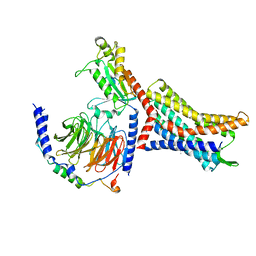 8u4nMC 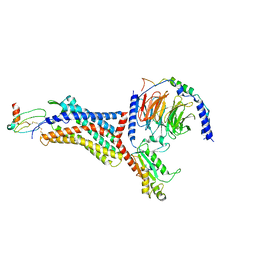 8u4oC 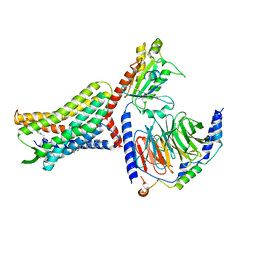 8u4pC 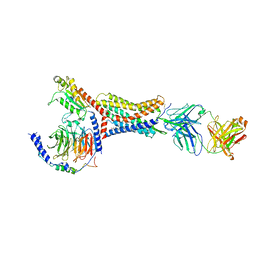 8u4qC 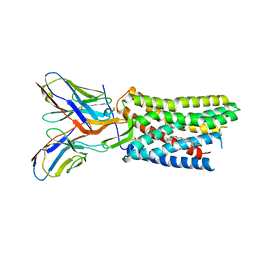 8u4rC 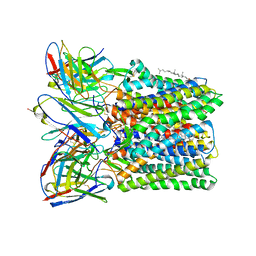 8u4sC 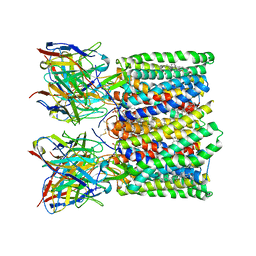 8u4tC C: 同じ文献を引用 ( M: このマップから作成された原子モデル |
|---|---|
| 類似構造データ | 類似検索 - 機能・相同性  F&H 検索 F&H 検索 |
- リンク
リンク
| EMDBのページ |  EMDB (EBI/PDBe) / EMDB (EBI/PDBe) /  EMDataResource EMDataResource |
|---|---|
| 「今月の分子」の関連する項目 |
- マップ
マップ
| ファイル |  ダウンロード / ファイル: emd_41888.map.gz / 形式: CCP4 / 大きさ: 103 MB / タイプ: IMAGE STORED AS FLOATING POINT NUMBER (4 BYTES) ダウンロード / ファイル: emd_41888.map.gz / 形式: CCP4 / 大きさ: 103 MB / タイプ: IMAGE STORED AS FLOATING POINT NUMBER (4 BYTES) | ||||||||||||||||||||
|---|---|---|---|---|---|---|---|---|---|---|---|---|---|---|---|---|---|---|---|---|---|
| ボクセルのサイズ | X=Y=Z: 0.696 Å | ||||||||||||||||||||
| 密度 |
| ||||||||||||||||||||
| 対称性 | 空間群: 1 | ||||||||||||||||||||
| 詳細 | EMDB XML:
|
-添付データ
- 試料の構成要素
試料の構成要素
-全体 : Apo CXCR4/Gi complex
| 全体 | 名称: Apo CXCR4/Gi complex |
|---|---|
| 要素 |
|
-超分子 #1: Apo CXCR4/Gi complex
| 超分子 | 名称: Apo CXCR4/Gi complex / タイプ: complex / ID: 1 / 親要素: 0 / 含まれる分子: #1-#4 |
|---|---|
| 由来(天然) | 生物種:  Homo sapiens (ヒト) Homo sapiens (ヒト) |
-分子 #1: Guanine nucleotide-binding protein G(i) subunit alpha-1
| 分子 | 名称: Guanine nucleotide-binding protein G(i) subunit alpha-1 タイプ: protein_or_peptide / ID: 1 / コピー数: 1 / 光学異性体: LEVO |
|---|---|
| 由来(天然) | 生物種:  Homo sapiens (ヒト) Homo sapiens (ヒト) |
| 分子量 | 理論値: 41.591312 KDa |
| 組換発現 | 生物種:  |
| 配列 | 文字列: MHHHHHHGGG GSGCTLSAED KAAVERSKMI DRNLREDGEK AAREVKLLLL GAGESGKCTI VKQMKIIHEA GYSEEECKQY KAVVYSNTI QSIIAIIRAM GRLKIDFGDS ARADDARQLF VLAGAAEEGF MTAELAGVIK RLWKDSGVQA CFNRSREYQL N DSAAYYLN ...文字列: MHHHHHHGGG GSGCTLSAED KAAVERSKMI DRNLREDGEK AAREVKLLLL GAGESGKCTI VKQMKIIHEA GYSEEECKQY KAVVYSNTI QSIIAIIRAM GRLKIDFGDS ARADDARQLF VLAGAAEEGF MTAELAGVIK RLWKDSGVQA CFNRSREYQL N DSAAYYLN DLDRIAQPNY IPTQQDVLRT RVKTTGIVET HFTFKDLHFK MFDVTAQRSE RKKWIHCFEG VTAIIFCVAL SD YDLVLAE DEEMNRMHAS MKLFDSICNN KWFTDTSIIL FLNKKDLFEE KIKKSPLTIC YPEYAGSNTY EEAAAYIQCQ FED LNKRKD TKEIYTHFTC STDTKNVQFV FDAVTDVIIK NNLKDCGLF UniProtKB: Guanine nucleotide-binding protein G(i) subunit alpha-1 |
-分子 #2: Guanine nucleotide-binding protein G(I)/G(S)/G(T) subunit beta-1
| 分子 | 名称: Guanine nucleotide-binding protein G(I)/G(S)/G(T) subunit beta-1 タイプ: protein_or_peptide / ID: 2 / コピー数: 1 / 光学異性体: LEVO |
|---|---|
| 由来(天然) | 生物種:  Homo sapiens (ヒト) Homo sapiens (ヒト) |
| 分子量 | 理論値: 38.534062 KDa |
| 組換発現 | 生物種:  |
| 配列 | 文字列: MHHHHHHGSS GSELDQLRQE AEQLKNQIRD ARKACADATL SQITNNIDPV GRIQMRTRRT LRGHLAKIYA MHWGTDSRLL VSASQDGKL IIWDSYTTNK VHAIPLRSSW VMTCAYAPSG NYVACGGLDN ICSIYNLKTR EGNVRVSREL AGHTGYLSCC R FLDDNQIV ...文字列: MHHHHHHGSS GSELDQLRQE AEQLKNQIRD ARKACADATL SQITNNIDPV GRIQMRTRRT LRGHLAKIYA MHWGTDSRLL VSASQDGKL IIWDSYTTNK VHAIPLRSSW VMTCAYAPSG NYVACGGLDN ICSIYNLKTR EGNVRVSREL AGHTGYLSCC R FLDDNQIV TSSGDTTCAL WDIETGQQTT TFTGHTGDVM SLSLAPDTRL FVSGACDASA KLWDVREGMC RQTFTGHESD IN AICFFPN GNAFATGSDD ATCRLFDLRA DQELMTYSHD NIICGITSVS FSKSGRLLLA GYDDFNCNVW DALKADRAGV LAG HDNRVS CLGVTDDGMA VATGSWDSFL KIWN UniProtKB: Guanine nucleotide-binding protein G(I)/G(S)/G(T) subunit beta-1 |
-分子 #3: Guanine nucleotide-binding protein G(I)/G(S)/G(O) subunit gamma-2
| 分子 | 名称: Guanine nucleotide-binding protein G(I)/G(S)/G(O) subunit gamma-2 タイプ: protein_or_peptide / ID: 3 / コピー数: 1 / 光学異性体: LEVO |
|---|---|
| 由来(天然) | 生物種:  Homo sapiens (ヒト) Homo sapiens (ヒト) |
| 分子量 | 理論値: 7.861143 KDa |
| 組換発現 | 生物種:  |
| 配列 | 文字列: MASNNTASIA QARKLVEQLK MEANIDRIKV SKAAADLMAY CEAHAKEDPL LTPVPASENP FREKKFFCAI L UniProtKB: Guanine nucleotide-binding protein G(I)/G(S)/G(O) subunit gamma-2 |
-分子 #4: C-X-C chemokine receptor type 4
| 分子 | 名称: C-X-C chemokine receptor type 4 / タイプ: protein_or_peptide / ID: 4 / コピー数: 1 / 光学異性体: LEVO |
|---|---|
| 由来(天然) | 生物種:  Homo sapiens (ヒト) Homo sapiens (ヒト) |
| 分子量 | 理論値: 71.063609 KDa |
| 組換発現 | 生物種:  |
| 配列 | 文字列: MKTIIALSYI FCLVFAGAPE GISIYTSDNY TEEMGSGDYD SMKEPCFREE NANFNKIFLP TIYSIIFLTG IVGNGLVILV MGYQKKLRS MTDKYRLHLS VADLLFVITL PFWAVDAVAN WYFGNFLCKA VHVIYTVSLY SSVLILAFIS LDRYLAIVHA T NSQRPRKL ...文字列: MKTIIALSYI FCLVFAGAPE GISIYTSDNY TEEMGSGDYD SMKEPCFREE NANFNKIFLP TIYSIIFLTG IVGNGLVILV MGYQKKLRS MTDKYRLHLS VADLLFVITL PFWAVDAVAN WYFGNFLCKA VHVIYTVSLY SSVLILAFIS LDRYLAIVHA T NSQRPRKL LAEKVVYVGV WIPALLLTIP DFIFANVSEA DDRYICDRFY PNDLWVVVFQ FQHIMVGLIL PGIVILSCYC II ISKLSHS KGHQKRKALK TTVILILAFF ACWLPYYIGI SIDSFILLEI IKQGCEFENT VHKWISITEA LAFFHCCLNP ILY AFLGAK FKTSAQHALT SVSRGSSLKI LSKGKRGGHS SVSTESESSS FHSSGRPLEV LFQGPGGGGS VSKGEELFTG VVPI LVELD GDVNGHKFSV SGEGEGDATY GKLTLKFICT TGKLPVPWPT LVTTLTYGVQ CFSRYPDHMK QHDFFKSAMP EGYVQ ERTI FFKDDGNYKT RAEVKFEGDT LVNRIELKGI DFKEDGNILG HKLEYNYNSH NVYIMADKQK NGIKVNFKIR HNIEDG SVQ LADHYQQNTP IGDGPVLLPD NHYLSTQSKL SKDPNEKRDH MVLLEFVTAA GITLGMDELY KDYKDDDDK UniProtKB: C-X-C chemokine receptor type 4 |
-分子 #5: CHOLESTEROL
| 分子 | 名称: CHOLESTEROL / タイプ: ligand / ID: 5 / コピー数: 1 / 式: CLR |
|---|---|
| 分子量 | 理論値: 386.654 Da |
| Chemical component information |  ChemComp-CLR: |
-実験情報
-構造解析
| 手法 | クライオ電子顕微鏡法 |
|---|---|
 解析 解析 | 単粒子再構成法 |
| 試料の集合状態 | particle |
- 試料調製
試料調製
| 緩衝液 | pH: 7.5 |
|---|---|
| 凍結 | 凍結剤: ETHANE |
- 電子顕微鏡法
電子顕微鏡法
| 顕微鏡 | TFS GLACIOS |
|---|---|
| 撮影 | フィルム・検出器のモデル: TFS FALCON 4i (4k x 4k) 平均電子線量: 50.0 e/Å2 |
| 電子線 | 加速電圧: 200 kV / 電子線源:  FIELD EMISSION GUN FIELD EMISSION GUN |
| 電子光学系 | 照射モード: FLOOD BEAM / 撮影モード: BRIGHT FIELD / 最大 デフォーカス(公称値): 2.0 µm / 最小 デフォーカス(公称値): 1.0 µm |
- 画像解析
画像解析
| 初期モデル | モデルのタイプ: NONE |
|---|---|
| 最終 再構成 | 解像度のタイプ: BY AUTHOR / 解像度: 2.72 Å / 解像度の算出法: FSC 0.143 CUT-OFF / 使用した粒子像数: 183399 |
| 初期 角度割当 | タイプ: MAXIMUM LIKELIHOOD |
| 最終 角度割当 | タイプ: MAXIMUM LIKELIHOOD |
 ムービー
ムービー コントローラー
コントローラー










































